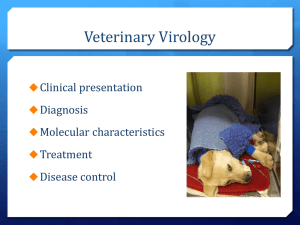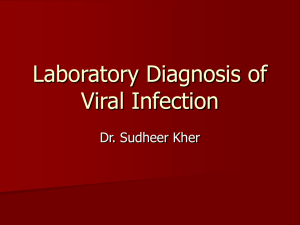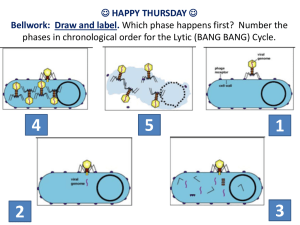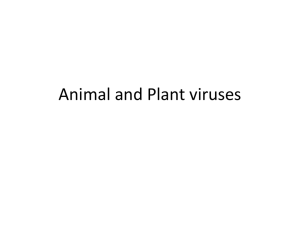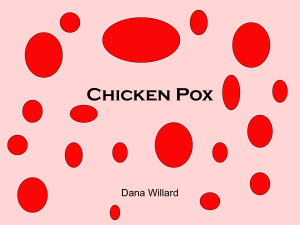Not
advertisement
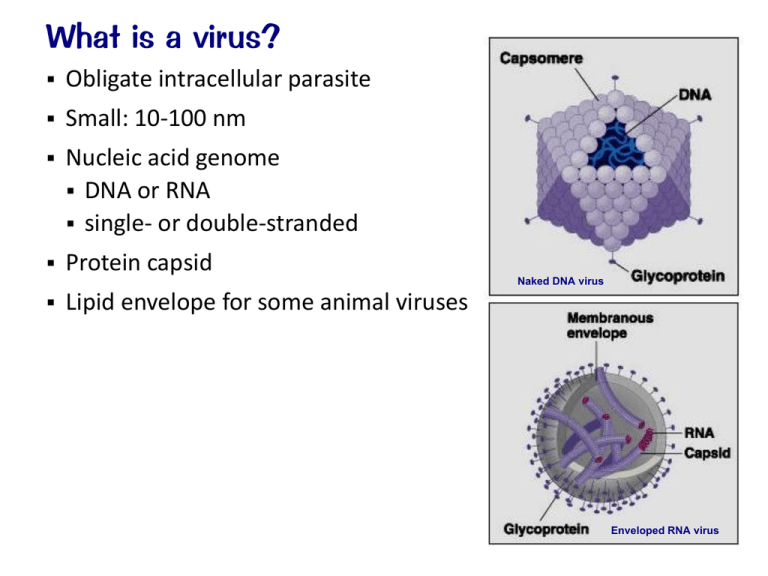
What is a virus? Obligate intracellular parasite Small: 10-100 nm Nucleic acid genome DNA or RNA single- or double-stranded Protein capsid Naked DNA virus Lipid envelope for some animal viruses Enveloped RNA virus Viruses don’t divide, they replicate No metabolism outside a host cell Requires host nucleotides, amino acids, enzymes, energy Genome directs host cell to make virus proteins Copies of genome + proteins assembled into new viruses Is a virus a cell? cells genetic material composition metabolism membrane size viruses Is a virus alive? living non-living Virus replication 1. Attachment 2. Entry 3. Uncoating 4. Nucleic acid replication & protein synthesis 5. Assembly 6. Exit Attachment Virus protein binds membrane receptor Determines host range host cell receptor virus “spike” protein HPV (naked) host cell receptor virus “spike” protein influenza virus (enveloped) Entry Naked virus usually enters by endocytosis Enveloped virus usually enters by fusion HPV (naked) influenza virus (enveloped) Uncoating Genome released from capsid proteins For naked virus, must also escape vesicle HPV (naked) influenza virus (enveloped) Replication Genome replicated Viral proteins synthesized by host ribosomes envelope proteins inserted into membrane HPV (naked) influenza virus (enveloped) Assembly Viral proteins self-assemble into capsid Viral proteins package genome HPV (naked) influenza virus (enveloped) Exit Naked virus lyses cell Enveloped virus “buds” out, taking membrane as envelope HPV (naked) influenza virus (enveloped) Antiviral drugs Useful drugs must be selectively toxic: Kill the disease-causing organism Leave host cells unharmed Antibiotics exploit differences between proks and euks: Unique cell wall carbohydrates in bacteria Unique structures of bacterial ribosomes Prokaryotic RNA polymerase Viruses replicate in our own cells, using our own machinery Antiviral drugs Acyclovir Herpes family: herpes, chicken pox, shingles, etc. Blocks viral DNA synthesis Reduces duration and severity of infection Antiviral drugs “Relenza” and relatives Influenza virus Prevents new budding viruses from detaching and spreading Reduces duration of flu by ~2 days Antiviral drugs HAART “cocktail” HIV virus Blocks 2 key viral enzymes Extends life Improves quality of life Vaccination Our best weapon against viruses so far Vaccination Inject safe form of viral proteins (antigens) Immune system produces antibodies and memory cells Fast response to actual virus prevents disease antibody production → anti-flu antibodies infection with actual flu virus “flu shot” (killed virus) ≈10 days time → 1-2 days Smallpox vaccination Smallpox killed 300,000,000 in the 20th century Edward Jenner developed vaccination in 1796 Vaccination allowed eradication of the disease Last case in 1977 Vaccination Polio should be the next disease to be eradicated 1988 350,000 cases 2010 968 cases Vaccine issues Vaccine development difficult for some diseases (e.g., HIV) Difficulty of universal distribution Side effects, real and imagined Public resistance to vaccination Sensational, irresponsible media coverage Not an economic priority for many drug companies Regulatory issues: >10 years to license a new vaccine Emerging viral diseases Mutation New influenza virus strains (need a shot every year) “Swine flu” or “Bird flu” becomes human flu pandemic? Species jump HIV probably evolved from a chimpanzee virus SARS coronavirus may have started as a bat virus Spread from isolated population Public attention/media

